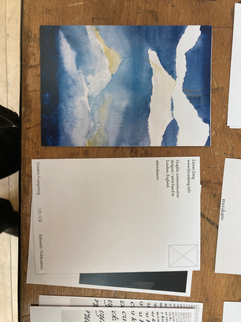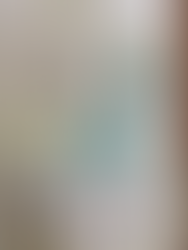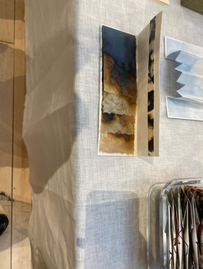Bookmarks & Interviews
- Crystal J Ann

- May 6, 2022
- 8 min read
30 March.
Interviews
Interview with Linran Jiang

"I live and practice in London, UK, with 6 years of experience in UI / UX and Brand, Advertising & Marketing. My passion lies in current human conditions, and articulate them using Graphic Communication. I take the discipline as means to advocate, understand and overcome – to inspire empathy, bridge gaps, and (maybe) have a chuckle."

- Why did you decide to go with the folding pattern?
- Because of the client, the puppetry organization of puppetry is the idea is to reflect this tradition, initial experience of the audience, because as an audience, you have to unfold the whole sheet as kind of like an exercise of manipulating shapes. That's the idea.
- So you're kind of going back to the whole manipulating puppets idea by sort of letting the client like the user, the audience manipulate the paper that they use?
-Yeah.

- And what about this one?
- Well, this one, this one was printed, completely printed on 200 sheets of tracing paper. I don't recommend this, to be honest. The idea of keeping a further dimension of the book because I was more treating it as a sculpture, rather than the very traditional media. Actually, I was going for the see through the quality of it (tracing paper). ...Because I wanted to give the topic I was working on a lot of volume. Yeah. As a sculpture.
- Thank you so much. So anything else you'd like to add about the books that you made and what maybe you've learned something from it?
- Specific to the books? I think you'll, you'll definitely learn a lot about the nature of language and the linearity of it and how to manipulate and response on this linearity. There's almost like the language itself being the string. Well, a thin line, how do you make the line thicker? how can we twist it and turn it into something more interesting?
Interview with Gen Harrison (typochondriacs)

- So I'm looking at books and I'm looking at what makes a book a book. I was looking at maybe making paper or like binding or just like forms of books. So I think I'm focusing more on the form of a book. And what is it that is giving it a form, just anything about the form of a book?
- Forms, I suppose, but I suppose yeah, and I suppose I quite like the idea of challenging Yeah, but can be it doesn't have to be a codex, you know, the spine and read in a certain way, you know, that's what can be immediately think of what artist books can be? Yeah. Yeah, be, I suppose I kind of look at them as containers of ideas really, container, and I suppose, suddenly, the graphic design degree, years ago, that whole idea of form following function, and the medium and the message, and just how the books that I make support, the content and how they work together as a whole. And I quite like them as sculptural things as well, I like them to function beyond just something you pick up, and look at and put down on the shelf, they could fit as a sculpture, we actually need to play, you know, you get a reward, I think from my books, I hope that you know, if you pick them up, interact with them, they will give you something. And I think it's the haptic isn't this all the touch?
- Yeah, so that is true. I think the best part about a physical book, this is what people bring up as well, when they talk about ebooks. What's the touch of a book?
- And of course, we'd be making artist books and book forms, where you've got creative control, from conception through to production, you can manage every element of that. From the way you bind it from the, from the paper that you choose the weight of that can transfer an idea or message or play around with that people subliminally, which is a really, really light. And it's interesting, because I work in most exclusively with letterpress, yeah, people respond to that as well. Because I have had situations where I've done maybe a digital proof of something just to work out the pagination and the imposition, I've had it there. And then I've had maybe a mock up, or a first proof book. And I've just had them sit, you know, and from a distance and pretty much the same. But people will come up and pick the one that is letterprinted. And it is that tactile thing. And it's beyond, it's beyond just engaging the vision to read, (it) engages all the senses, which is why I like it.
- That will be the whole idea that I'm focusing on for my research as well is like the medium is the message. What is the book? What makes a book a book? Like, what does it have to have? And if I'm telling a story, why, how can I tell it in the form of a book? How can I make a difference when people will look at that? Is it a book? And then they read it? And then like, maybe it's a book? If not?
I think the moment you got someone thinking about it, you've got them hooked? Yeah, because they've not just picked it up, flick through passively. It's like, what is this? Why does this work? Yeah, you can subvert that as well, I think the lead is gonna be I really like it because it's got so many infinite variations of work. And I'd say engaging, because you have to pick it up.

-Yeah. Is there anything that you like from here that you would want to maybe pick out and talk about?
Oh, really, I think they all have their charms. I suppose it's a bit like any process, like go on this, we're really excited about the idea. And then I don't think any, but if it doesn't make me swear at some point, and it's done, it's not doing its job. They do have that bit where you fall out of love with it, you might have to like, you know, just leave it for a while, and then you get dumped forever. Other people, they redeem themselves on the second looking so I suppose in terms of things that I like, probably the one thing that I do like is the structure yeah, I've actually sold out of today, which is great because it also shows that everybody liked and that was a lotus fold book. So it kind of opens up and it's an it is an interesting engagement because you have to do it and again, it was something that just really really worked with the idea and then I found the structure and then they just all a bit like you finding me here today. All everything lined up. Yeah, like That's really cool. .

- like a Jacob's Ladder. That was just, so again, that was, I'm liking that because I actually managed to make it work. I got up, because I've worked out it out. I'm gonna go and have a cup of tea, and then we're gonna make the addition. And by the time I got back from a cup of tea, I've completely forgotten again. So things like that. Well, you know, you've got that idea. You know you need to get there. But then it works. And yeah, I did that for an exhibition. Just before Christmas. Actually, National Library of Scotland bought a copy for their library. So it's like, oh, no, maybe it wasn't a bad idea of how's it attached together? It's actually bits of recycled plastic. Usually, traditionally, what I got as a child was bits of wood and ribbon. I think what I'm gonna do is I'm gonna go back and work out how I did it. And then I'm gonna put out a note to say anyone who's interested, come down for a little workshop in the print workshop. And we'll make them together. Yeah, like, please. I think I'm much better at explaining it by doing it.
- What inspired me because I was struggling for this was the color of this exhibition, and the want to make something for it. And I was kicking around stuff and not really. And then I was clearing out my daughter's just 18 and just off to uni. So basically went into a cupboard that she's not really interested. She was about seven. And one of the things that was in there was the Jacob's Ladder that Santa bought her when she was about three. I think that's it. But yeah, so that's fun. I like things that are fun. If it makes someone smile if it makes them think. And again, this one was just really strange. I think this I like this one because it was so simple. It just came together really quickly as a concertina, but but I wanted it to stand as a sculpture as well. So just making the cover actually work as a stands. I don't know, maybe it's a little bit of a preprint engineer in me or something. I don't know. There's something about the structure.
Interview with Kirstine J Drysdale (kjdrysdale.com)

- Oh, that's wonderful. I just love this one. As based on the screen, you see, it's different lengths of paper that have been created by the same mechanism was roses on the same semi paper, and then sewn together and scrolled.
- So when you keep it open, it turns, it almost looks like a flower. And it's so beautiful.
- When you open it, and like the style book, and more visual columns, trying to say a message and one all sorts of different types of messages or whatever by that but I'm more visual intellectual so my language is more visual than textual. Because with the artists book, sometimes you start with the, the form of the book. And sometimes you start with the paper or the card and you do something with it as I did on there is a classic. This is handmade paper, and I treated it, and I got a surprise, because I didn't think it was gonna work at all. And I just sat looking at this piece of paper at this big and thought, well, what am I going to do with you because I didn't make the paper myself. I bought the the paper but it is beautiful paper. And then that's the inks.

- Again, this is inks. Actually, that's really quink. And PVA. If you get a call the dark blue quink, only when only the blue quink, not a black quink, you know, the blue is called the blue, black, blue. And you put some PVA glue, just a thin covering, and then drops of the crank, and then just sort of spread it around and it separates out. So you get and you get shiny finish.

- I found it by surprise, trial and error. But yes, I'm being taught in the class. The teacher Susie, she's worked us hard. Very hard, but she was excellent. She would teach us different folds, and then just using plain English, printed paper. And then we would have to then start using our imagination about how we could turn this into something else. So for example, these as called the Turkish map fold, because that was how maps into Turkey. Many, many, many years ago, were folded supposedly, so they would open very easily. And we did and then I thought, well, what happens if you nest smaller and smaller and smaller pieces inside? That's that's really as far as that'll open. But there are three layers in there. Yeah. That's what happens if you do that. The first one I did went smaller and smaller and smaller. There is actually one of these there's actually this big I got for free time is I kind of do many of them. But yet so often, it comes from a different mixture of things.

- We're also taught how to bind books. So making more traditional style of book I'm using that technique in different ways. So everything from the scroll, which is a very simple, very simple scroll. And what's inside is very simple, but sometimes you can make it very complicated when you see that it doesn't look like anything. So you unwrap it, which could just simply be a simple single sheet that beautiful or it can be something more combat. So, for me anyway, part of it is to make something that makes you want to open it but when you do connects you go wow, this one very simple doesn't look like there's anything very much in it but that's because when you open it that paper is very, very thin, It's Sumi paper so it's very thin and it's been printed on and again it could be it could be anything.
Gallery
Linran Jiang
Gen
introduction to artists books
Susie Wilson















































































































































































































































































































































Comments